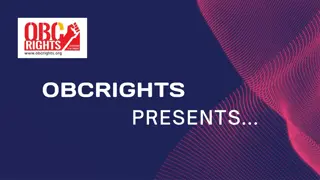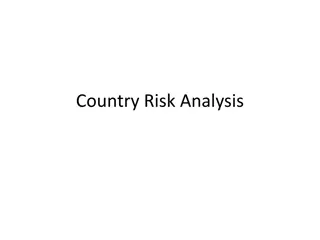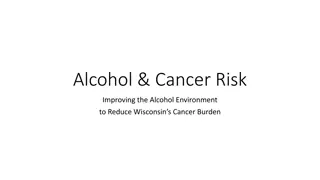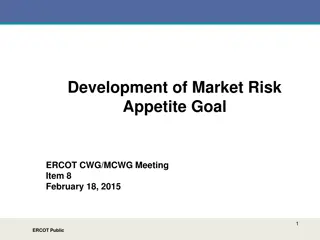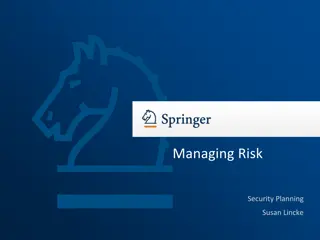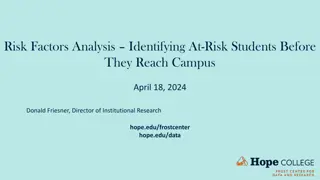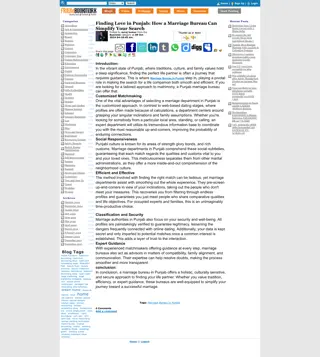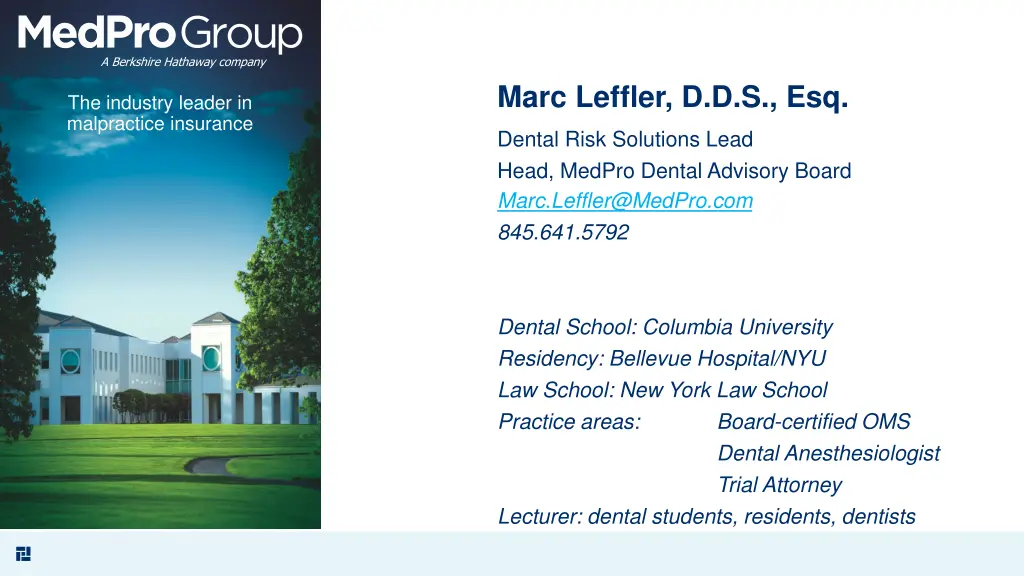
Ethics in Dental Practice and Malpractice Insurance
Explore the risks associated with non-adherence in dental practice, ethics, and the malpractice insurance relationship. Learn from industry leader Marc Leffler about ethics issues in the clinical setting, ADA principles of ethics, and the importance of patient autonomy and justice in dental care.
Download Presentation

Please find below an Image/Link to download the presentation.
The content on the website is provided AS IS for your information and personal use only. It may not be sold, licensed, or shared on other websites without obtaining consent from the author. If you encounter any issues during the download, it is possible that the publisher has removed the file from their server.
You are allowed to download the files provided on this website for personal or commercial use, subject to the condition that they are used lawfully. All files are the property of their respective owners.
The content on the website is provided AS IS for your information and personal use only. It may not be sold, licensed, or shared on other websites without obtaining consent from the author.
E N D
Presentation Transcript
A Berkshire Hathaway company Marc Leffler, D.D.S., Esq. The industry leader in malpractice insurance Dental Risk Solutions Lead Head, MedPro Dental Advisory Board Marc.Leffler@MedPro.com 845.641.5792 Dental School: Columbia University Residency: Bellevue Hospital/NYU Law School: New York Law School Practice areas: Board-certified OMS Dental Anesthesiologist Trial Attorney Lecturer: dental students, residents, dentists
ETHICS IN DENTAL PRACTICE: THE RISKS ASSOCIATED WITH NON- ADHERENCE CLINICALLY, AND THE ETHICS/MALPRACTICE RELATIONSHIP Punjabi Dental Society Montebello, California July 2025 2
Disclaimer/Conflicts Statement MedPro Group receives no commercial support from any ineligible company/ commercial interest. Neither MedPro Group nor the speaker have any conflicts of interests to report. It is the policy of MedPro Group to require that all parties in a position to influence the content of this activity disclose the existence of any relevant financial relationship with any ineligible company/commercial interest. When there are relevant financial relationships mitigation steps are taken. Additionally, the individual(s) will be listed by name, along with the name of the commercial interest with which the person has a relationship and the nature of the relationship. Today s faculty, as well as CE planners, content developers, reviewers, editors, and Risk Solutions staff at MedPro Group, have reported that they have no relevant financial relationships with any commercial interests. The information contained herein and presented by the speaker is based on sources believed to be accurate at the time they were referenced. The speaker has made a reasonable effort to ensure the accuracy of the information presented; however, no warranty or representation is made as to such accuracy. The speaker is not engaged in rendering legal or other professional services. The information contained herein does not constitute legal or medical advice and should not be construed as rules or establishing a standard of care. Because the facts applicable to your situation may vary, or the laws applicable in your jurisdiction may differ, if legal advice or other expert legal assistance is required, the services of an attorney or other competent legal professional should be sought. 3
ADA Principles of Ethics & Code of Professional Conduct "Codification" by ADA Council on Ethics, Bylaws and Judicial Affairs 5 Prevailing Principles to Guide Practice Patient Autonomy (and self-determination) Non-maleficence (non-malfeasance) Veracity (truthfulness) Beneficence (do good) Justice (fairness) But there are others, too, by inference and practicality Patient discharge without abandonment Social media limitations Patient rights vs. dentist rights Assisting patients who leave Ready access to records within HIPAA constraints Passing the treatment baton to other dentists 4
Ethics Issues in the Clinical Setting - - More Questions than Answers JADA, April 2025, Ambrosino Basic (abbreviated) fact pattern presented: mother brings 10 y.o. daughter to her first dental appointment; dentist finds 14 carious lesions; mother refuses any treatment with fluoride; water source at home is not fluoridated (well water); dentist is of the view that the mother's position is placing the child's health at risk, as evidenced by the current state of decay; dentist is aware of a non-fluoride (hydroxyl-apetite-based) toothpaste which is anti-caries, but he believes less so than fluoride, that brands itself as "aggressive[ly] antifluoride", which might justify mother's position more strongly. Ethical principles involved, some competing: Patient/mother autonomy - - dentist is obligated to respect mother's rights to self-determination Non-maleficence - - dentist is obligated to "do no harm" (to the child) Veracity - - dentist is obligated not to misrepresent dental treatment Author's ethics-based conclusions: the goal is oral health, so the best way to achieve that is to cooperate with the mother Is prioritization of principles of ethics appropriate, and whose prioritization carries the day? In other words, is autonomy above non-maleficence, or vice versa? Is veracity affected by that? 5
And what about malpractice implications? First, a review of the malpractice "definition": (1) violation of the standard of care (SOC) which (2) directly causes (3) injury to the patient. And SOC = what a reasonably prudent dentist would do under similar circumstances. All to be "proven" by way of expert opinion. So, suppose the child continued to develop caries and developed a Ludwig's angina, requiring hospitalization with extraoral I&D, leaving a permanent facial scar. Plaintiff's (patient's) expert testifies that, irrespective of the ethics-based determination the dentist made, to allow the mother's self-determination (autonomy), the dentist should have known better, and because he tacitly went along with a protocol in a high caries index patient that was not dentally sound, i.e., a violation of the SOC, the child was injured. If a jury accepts that point of view, the dentist is financially liable for the child's injuries. Moral: SOC does not necessarily = proper ethics (or what some consider proper)! 6
What Impact Do Ethical Breaches Have? JADA, March 2025 (Huang, et al.) Review of Texas Dental Board disciplinary actions against general dentists 39% - inadequate records 23% - lack of ethics and professionalism 6% - renewal issues 32% clinical inadequacies Query: Who determines what is adequate and ethical? The Board members. Based upon what? 7
The difference between Dental Boards and Juries What do Dental Boards "discipline" for? - Clinical incompetence = malpractice (generally gross malpractice) - Professional misconduct = ethics - Dishonest business practices = ethics - Substance abuse = ethics - Prescription drug violations = ethics and criminal - Overbilling = ethics and ?criminal - Breaching patient confidentiality = ethics and ?criminal - Sexual misconduct = ethics and criminal - Other Dental Practice Act violations = ethics (generally) What do Juries "discipline" for? - Malpractice - Lack of informed consent (quasi-malpractice) 8
Topic Overview Patient Autonomy is not patient autocracy "Do No Harm" (Non-maleficence), i.e., Work Within Your (Known) Abilities Not every "Harm" inflicted is an ethical breach, but it could be malpractice Referrals in the world of a new employee dentist Veracity: let's address a specific billing issue Patient discharge is fine (usually); abandonment never is Once a patient, always a patient: you signed on to help them, even as they move on and away from you Social media: do limitations make it a necessary evil? And don't forget about emailing and texting Guidelines, CBCTs, Teledentistry and Robotics 9
Patient Autonomy While a patient can dictate what they refuse, they cannot dictate what you must do. Autonomy only goes so far as to the end of dental ethical limits In other words, patient autocracy won't or at least shouldn't fly Patient safety, not necessarily patient desire, must carry the day (but recall the fluoride case earlier) Case Background Facts A 50-year-old woman presents, late on the afternoon of April 30, to her general dentist with severe pain on a lower second molar, which is the only posterior tooth in the quadrant, serving as an (important) abutment for a lower removable partial denture. Clinical and radiographic evaluation lead the dentist to conclude that tooth #18 has an irreversible pulpitis, so extraction or RCT were the available options presented; the patient wanted to save the tooth and opted for RCT. The dentist, who does not perform molar endodontics, called several local endodontists, but none could see the patient until Monday. The patient expressed to the dentist that her dental insurance coverage was to end at midnight, so she said, "you absolutely must do this for me!" 10
The Dentist Accedes The dentist reiterated that she did not feel comfortable doing molar RCT, especially on a second molar and particularly on one so critical to function. The dentist offered prescriptions for pain meds and antibiotics to help the patient get through the weekend, until an endodontist could see her first thing Monday morning. The patient insisted: "I've been your patient for so long, and I need this favor, so I won't take 'no' for an answer!" Feeling a host of emotions telling her not to do what she knew she was not expert at doing, she felt ethically obligated to help out her patient who needed help so badly. The dentist agreed to go along with the demanded procedure. 11
The Treatment Proceeds The dentist entered into the pulp chamber using a round bur in a high speed handpiece, and as she made her way toward the canals, she saw blood come into the field. Concerned that the bleeding was not from a hyperemic pulp, but rather a perforation, she took a radiograph, which confirmed that it was a perforation into the furcation area, and was in fact sizable. Believing that the tooth was no longer restorable, she explained that the tooth needed to be extracted, which would then require at least a partial denture modification, but more likely a remake and redesign. The patient was visibly upset and annoyed, as she agreed to the extraction, which was done right then, without complication. Within a few weeks, with the patient then uninsured, she presented to a new dentist, who suggested a treatment plan that called for multiple implants to be placed in both lower left posterior quadrants, at a cost beyond the patient's means. 12
The Ethics-Malpractice Merger The patient retained an attorney, who took 2 actions against the dentist: a suit was filed for dental malpractice; and a breach-of-ethics claim was filed with the State Dental Board for agreeing to perform a procedure which the dentist had acknowledged to the patient was not one that she felt comfortable doing, all to the patient's detriment. The malpractice action settled rather quickly. The dentist argued to the Board that she had done what the patient wanted to be done, which fulfilled her obligation to satisfy patient autonomy. The Board did not concur: instead, it determined that the dentist had breached her ethical obligation in succumbing to a patient demand that she knew she could not meet, reasoning further that "patient autonomy means, practically, that patients have an absolute right to choose between various viable options, or to choose no treatment at all, but it does not mean that all patient demands must be carried out, especially to the disadvantage of that patient". Query if the malpractice case had gone to trial following the Board's determination. The moral of this ethics story: While a patient can dictate what they refuse, they cannot dictate what you must do. That is not what patient autonomy is all about. 13
ADA Code of Ethics, Section 2, Non-maleficence ("Do No Harm, and Protect Patients From It") Referral isn't a bad thing, even if your boss disagrees and exerts pressure The ethics of the "loan payment" conundrum (January 2020 NYS Dental Journal; Marc Leffler, William Spiegel) 14
Non-Maleficence Case Background Facts Dr. N is a recent dental school graduate in his first dental job, which pays him well. He is married with a newborn, and his previously-employed spouse is taking an indefinite hiatus from work to raise the child. Like many new dentists, Dr. N has substantial dental school loans to repay (his being more than $400,000), in addition to now being the sole financial supporter of a family living in a house with a mortgage. Needless to say, Dr. N must keep his job. Dr. N's supervisor, an experienced dentist, approaches Dr. N to advise him that a patient just presented with swelling and pain associated with an impacted lower third molar, and after radiographs were complete, Dr. N was to extract it. Dr. N expressed that he had never removed an impacted tooth before, but only assisted on a few of them in dental school, so he preferred to refer the patient to an oral surgeon or other dentist more surgically experienced. The supervisor responded that this assignment was not an option. "In this office, we do not refer patients out; this is part of your job. You'll learn." Considering his personal life circumstances, Dr. N quickly realized that he needed to treat this patient, despite his knowing that he was certainly not the best practitioner to do so. 15
The Treatment Proceeds When Dr. N seated his new patient, he noted radiographically that tooth #32 was a fully impacted, mesioangular tooth, with roots in radiographic close proximity to the inferior alveolar canal, so a paresthesia risk was a realistic potential outcome of extraction. Dr. N explained this and the other usual risks to the patient. As he had anticipated, Dr. N got "lost" during the procedure as he continued to remove bone and tooth structure with round and fissure burs, and he believed that he had completed the procedure some 2 hours later. When the patient returned for a post-op visit in a week, and reported profound lower lip and chin numbness on the right, Dr. N took a radiograph, only to find portions of the root still in place, as well as visible bur cuts through the roof of the inferior alveolar canal. The patient never returned but filed both a lawsuit for negligent treatment (malpractice) and a Dental Board complaint over "grossly negligent treatment and professional misconduct". The Board found that Dr. N violated the ethical tenet to "do no harm", fined him, and levied a partial suspension from practice for 6 months, during which time he could only practice if under the "direct supervision of a licensed dentist". 16
The Moral of this Ethics Story Practice within your abilities, regardless of pressures placed by supervisors or patients, lest the Dental Board might institute sanctions, some of which can be severe! This holds regardless of how many years of practice have passed. Ethical rules do not take into account personal life obligations which lead to potential violations of those rules; the violations are all that matter. More and more frequently, patients/attorneys file Board complaints in tandem with malpractice suits, perhaps as leverage. [Some jurisdictions allow in Board actions as malpractice trial evidence.] 17
Veracity Effects of the "No Surprises Act (NSA)": Confusion Abounds The "anti" to Balance Billing: out-of-network practitioner charging the difference between medical/dental fees billed and insurance company payment By some interpretations, balance billing used to be required, to comply with law and ethics Example: $100 usual-fee procedure billed at $100; insurance pays 80% ($80); balance billing says bill patient $20. If the $20 is not billed, and $80 is accepted in full, then $80 is the real fee, and it should have been billed in the first place (to maintain ethics and law); but then, insurance would have paid $64 (80% of $80) Does this demonstrate a violation of Veracity? But the federal NSA took effect January 1, 2022: protects patients from "surprise bills" after getting emergency care, non-emergency care at in-network facilities performed by out-of- network providers, and out-of-network air ambulance services. In February 2023, CMS notified the ADA that, generally, dental services are "excepted" (not included) from the NSA. Although OMSs and other dentists who treat in hospitals or outside facilities (like ambulatory care centers) might be included So, does that mean dentists may still balance bill? Must they still balance bill? Perhaps, but open questions until courts interpret this federal legislation, and analogous state rules 18
Discharge Without Abandonment What crosses over from "OK" to "not OK"? Discharge limited by discrimination - - protected classes per SCOTUS and state courts Dismissal = the formal discharge of a patient from a practice or facility Abandonment = the inappropriate dismissal of a patient by virtue of leaving them "high and dry" in the midst of an irreversible treatment or treatment plan Is dismissal appropriate ever? Your judgment call. But if so, how do you prevent dismissal from becoming abandonment? Make it formal with a writing Explain to the patient why even if unpleasant Make sure the patient is stable and not midstream -but think about orthodontics! Be available for a reasonable time period Assist with chart transfer to new dentist, if patient requests Assist by talking with new dentist, if patient requests Never dismiss for a discriminatory purpose Communicate cordially and professionally Think long and hard about billing, and then about collection! Never fight back on social media (more shortly) HIPAA still applies 19
When They Want to Leave: Once a Patient Always a Patient (to an extent) No, you don't need to treat them forever But Ethics rules can be read to suggest a need to protect them after they leave (within reason) Do no harm Don't abandon Provide them with ready access to all records (broadly considered), with HIPAA-compliant request Ethics is a separate issue from HIPAA requirements Copying/reproducing fees are dictated per State, but consider the reaction that might trigger Assist them with transfer of care to another dentist Send records, if requested General explanation of care you provided to patient and dentist, if requested Be a "friend", not a "foe", regardless of any bad feelings This is a period of high vulnerability for being sued, especially if there's "jousting", yet another ethics issue 20
The Perils of Social Media Patients have 100% HIPAA rights and waiver determination If a patient criticizes you on social media, you're not a restaurant or hotel, so you must keep silent unless patient waives their privacy rights Even a "thank you for your comment" for a positive review can be a violation Penalties for HIPAA violations: monetary fines or even prison for extreme violations Suggestion: on dental office social media site, include something like, "we respect and appreciate comments from our patients, whether positive or negative, but patient privacy rights do not permit us to respond in the public domain; however, we will reach out privately to all commenters", so site visitors don't think you just ignore comments by not addressing them publicly. That's not so easy on open review sites, so a similar statement on the practice website is a substitute, if not an ideal one. 21
Wow, have our methods of communication changed! What's a letter, envelope, return address, stamp? Dental chart recording Handwritten (careful: ink can be dated and its specific pen source found) EMR/EDR Embeds (careful: time, date, author, location created, re-entries, ) Emails, texts, emojis Part of the patient chart Keep it professional, even though the method is casual Avoid emojis, at all costs Happy or sad face emojis are not appropriate professional expressions That alone can be viewed as professional misconduct, an ethical breach And jurors won't like it 22
Blood Pressure "Guidelines" ADA: elective dental procedures should be cancelled for patients with BP readings greater than 160/100, and 180/110 for urgent treatment In favor of a medical evaluation first Is this the Standard of Care? It's only a Guideline; it's expert testimony as to what is SOC. But what do you think an expert against you will testify to? But Dental Boards don't necessarily follow Court rules. Per 2023 study, only 4% of dental patients with BP elevated above those values had treatment deferred! Implications Every patient presenting for any procedure must have BP taken Or else you can't know if it's elevated Potential malpractice liability in the event of a cardiovascular episode But what is an "elective" or "urgent" procedure? Do you want to leave that determination to a jury or the Dental Board? Potential Ethics breach finding by Dental Board (more shortly) Benefits Dentists will likely be the ones who initially diagnose or alert to the possibility of hypertension A great service to the community Demonstrative of dentists' role in overall health, rather than only oral health Patient appreciation - - word spreads IT ONLY TAKES A MINUTE, SO JUST DO IT! (Thanks Nike) 23
Do ADA/AGD/AAOMS, etc. "Guidelines" = SOC in Court? The answer should lie with, "I can't cross-examine a piece of paper". Some judges might, however, allow it into evidence, regardless But as said before experts might see them as equals and legitimately (or not) use them A reference to Association Guidelines if that reference is allowed gives extra credibility Jurors more likely to see that as "fact" rather than "opinion" My Cousin Vinny: "Ms. Vito, are you stating that as fact or opinion?" "Oh, it's a fact!" At least 1 state's Dental Board views ADA guidelines as the SOC And likely more than just 1 24
CBCT Issues A growing trend, especially for implants, impactions, endodontics "Wide" view Potential responsibility for everything that should be seen but missed What if you focus it down, so only the desired area is "shown" to you; the remainder is still in there Is ignorance bliss? What to do with Wide view CBCT sent by general dentist? Should it be opened? If not, what to tell patient who just paid for it, and was exposed to it, and now needs to pay and be exposed again Perhaps more important: is ignorance bliss, once again? Not an open and shut answer. Discussions with referrers "Limited" of "Focused" view Just what you need is taken; contrast with focused views - - it's a big difference "Ideally" limits responsibility to your area of expertise Potentially better accuracy 25
So, Is Ignorance Bliss? Let's Look at a Case General dentist orders a CBCT study, by an OMFRadiologist, in advance of implant placement in the mandible. OMFRad locates various potential placement sites in a report generated to the dentist, as had been requested. No other findings noted. Dentist places 5 implants uneventfully, and they are ultimately restored. 7 months after the CBCT, the 63-year-old male patient suffers a stroke. Hospital work-up reveals radiopaque plaque in left carotid artery, which is determined as the presumptive cause of the stroke. Neurologist asks wife if patient had ever had any radiographs of his head and neck regions, to which she responded, "as a matter of fact, he had a CBCT scan for implants 7 months ago". Neurologist and medical radiologist obtain and review the CBCT, and determine that the same plaque was present and readily identifiable. Patient sues dentist and OMFRad for failing to diagnose, thereby leading to stroke. 26
Negligence/Causation Theories and Questions 1. OMFRadiologist failed to diagnose what was there to be seen. -Even though not in an area that was the study focus. Should focused- rather than wide-view study have been performed? -Would that eliminate liability? -What are those ethics implications? (Next slide) Does your training provide you with the tools to make "non-dental" evaluations? If not, how can you modify your practice? Remember, it's the procedure, not the type of practitioner, that carries a SOC. -It wouldn't be fair to patients the other way around. Would an earlier finding of the arterial plaque have led to a different result? If not, no case. (Negligence + causation required.) Quasi-related but worth the thought: is CBCT the SOC prior to implant placement? (Next slide) 2. 3. 4. 5. 27
Another Malpractice Case with Ethics Issues 50 y.o. male presents for single implant in area of #30, where tooth had been lost 2 years prior. Periodontist takes PA which captures entire site, and which "demonstrates" IAC 15.5 mm from crest. 13mm implant chosen. Following a reported uneventful procedure, patient presents a week later for scheduled post-op with complaint of paresthesia of right lower lip and chin. Perio says it will most likely resolve, so "let's see how it goes". Does that comport with "Do no Harm"? Patient lost to follow but presents to OMS at 4+ months, who does CBCT and finds IAN impingement; implant is integrated. Numbness remains permanently. Any valid theories for negligence? 28
Theories Underlying the Case Adequacy of radiograph Is a PA adequate? What is the SOC? How widespread before CBCT reaches SOC? Roughly only 1/3 of GPs and 2/3 of dental specialists have them. (Total approx. 40%, as 80% of all dentists are GPs.) Are the remaining 60% breaching ethics? No timely action taken prior to integration Diagnostic post-placement radiograph Referral Implant removal 1. 2. 29
Is CBCT Use Mandatory to Meet the SOC/Ethics? For implants, impactions, endo, diagnosis?? Maybe Like so much in malpractice litigation, that depends upon the opinion from the witness stand If so, consider the ethical implications: "Do no harm" can be viewed to require CBCT use for implants, impactions, endo "Do no harm" can be viewed to require CBCT use even to do an exam "Do no harm" can be viewed to say "don't practice dentistry of any type without CBCT" "Do no harm" can be viewed as always needing a "wide" view If so, consider the malpractice/SOC implications: Potentially, exactly the same on this issue as the ethical implications So, does an ethics breach = malpractice? In reality, up to a jury. So what's the answer? Let's look at history First reported use of dental radiographs c.1900 Routine use of dental radiographs c.1950 Was 50 years of dentistry being done unethically and outside the SOC? 30
The Ethics of Teledentistry Teledentistry: the use of remote visual and/or audio platforms to "perform" dentistry Therefore, a traditional phone call between dentist and patient is actually teledentistry And that's been done for many years, well before Zoom, WebEx, Teams, etc. NYS recent legislation: all standards for in-person dental visits must be maintained for teledentistry visits [Wonder if there was a dentist on the legislative team?] It's hard enough to see the floor of mouth adjacent to #17 in person, with light, mirror, lenses A remote view, with the best of computer cameras and lighting cannot be the same Likely refers to ethics as well What about interstate? Is that practicing without a license in an adjacent state? What about a post-op call from NY to NJ? Which state's Courts and Dental Boards have jurisdiction? MedPro hasn't seen any cases yet for teledentistry ethical or practice standard breaches But you don't need a crystal ball 31
Dentistry Performed by Robots An AI-controlled robot is claimed to be able to autonomously fabricate a crown in 15 minutes (as compared with 2 dentist hours over 2 visits) The robot uses a handheld 3D scanner to capture supra- and sub-gingival images The robot is claimed to be able to perform the tasks even on moving patients The manufacturer of the first advertised dentistry robot is Perceptive But there might be others, now or in the future 32
Risk Concerns Are there ethical concerns about delegating duties to robots/AI? Other procedures likely on the horizon Where does that end? Will robots be able to diagnose? Who/what is liable when things go wrong (as they inevitably will)? The dentist? The dentist's tech manager? Does that flow back to the dentist vicariously? The manufacturer? Where does underwriting step into this picture? How will premium rate be affected? If so, will it raise or lower it? And don't forget about what Dental Board members might consider to be "professional misconduct", constituting an Ethics breach! 33
Dental Ethics and Sleep Deprivation JADA, July 2025: "Are there ethical implications in providing treatment while sleep deprived?" By Peter P. Korch, DMD The scenario: flight delays on the way home from vacation or a meeting; arrive just before office opens, having had no sleep the prior night. "Imagine that a patient comes into the office on this particular day with a severe toothache. You have admitted your condition to the patient, and they request that you proceed anyway. You are in the office, and they are in pain. You have informed the patient, and they have consented. This covers the legal side of the situation. [Does it?] Putting aside the question as to whether someone in pain is making a rational request, is it ethical for you to proceed in providing treatment? This is where you have to weigh the principles. Principle of Autonomy? Check, the patient has provided informed consent. Principle of Veracity? Covered, you have truthfully communicated the situation. The principle of Beneficence says yes, eliminate their pain if you are able. However, can you, in your present state? Are you capable of competently providing treatment without risking harm, as required by the principle of Nonmaleficence? That is a question only you can answer." 34
Thank you for your attention! Questions? Comments? Marc Leffler, DDS, Esq. 845-641-5792 Marc.Leffler@MedPro.com 35




